India’s Successful Hypersonic Vehicle Test

On September 7, 2020, the Defence Research & Development Organisation (DRDO) successfully conducted a test of its wholly indigenous Hypersonic Technology Demonstrator Vehicle (HSTDV) which has been under development for well over a decade.
HSTDV was launched aboard an Agni missile booster rocket from the APJ Abdul Kalam testing range on Wheeler Island off Balasore, Odisha, at 11:03 a.m. The rocket reached an altitude of 30 kilometres (about 100,000 feet) when the HSDTV separated, its air intake opened, which then automatically triggered firing of the air-breathing scramjet (or supersonic ramjet as explained later engine. The combustion sustained for more than 20 seconds, with the vehicle achieving a cruise velocity of Mach 6 (about 6,600 kmph or 2km/second at this altitude), the main criteria to deem the test a success.
DRDO said, “the vehicle performed successfully on all the pre-determined parameters including the ability to handle combustion temperatures of over 2500 degrees Celsius as well as air speed.”
According to DRDO spokespersons, the HSDTV also demonstrated near-perfect performance with respect to various other technologies and parameters, such as separation of vehicle from booster at hypersonic velocity, fuel injection, auto-initiation of ignition, aerodynamics for hypersonic manoeuvres, sustained combustion at hypersonic airflow speeds, heat and structural performance of special materials at high temperatures.
With this, India has joined a small club of countries with proven capabilities in hypersonic vehicles, namely the US, Russia and China, while a handful of other countries such as Japan, Australia, France and the UK also have significant capabilities in this area. DRDO will now undertake further development towards deployable hypersonic vehicles for different applications, which may now be expected to fructify starting around five years from now.
Scramjet Engines
Hypersonic aerial vehicles powered by fuel-efficient scramjet engines travel at very high speeds of around six times the speed of sound (Mach 6) at high trans-atmospheric altitudes, and then descend at similar velocities, usually with aerodynamic high-speed manoeuvring ability unlike conventional ballistic vehicles.
As such, hypersonic aerial vehicles have many applications such as reusable space launch vehicles, low-cost satellite launches and of course new-generation missiles. Hypersonic vehicles also involve many new technologies, materials etc., thus opening up prospects for diverse industries. These aspects are now briefly examined.
After several rudimentary efforts, serious efforts to develop air-breathing engines or ramjets started in different countries after World War II, during which jet engines and rockets had made their appearance. Ramjet engines are like flying nozzles which use their forward velocity to compress inlet air which is then burned using some fuel, usually hydrogen, and then exhausted at high velocity to generate thrust. Unlike the usual jet engines, there are no rotating compressors or turbines and numerous other moving parts, thus reducing weight, manufacturing complexity and maintenance requirements, while saving considerable fuel. However, since ramjets require substantial forward velocity to begin functioning, vehicles powered by such engines cannot start from standstill and need to be launched by another vehicle, such as a rocket, till it attains sufficient velocity.
Ramjets usually work efficiently at around Mach 3, but can go till Mach 5 or 6. In ramjet engines, inlet air at supersonic speed is compressed and speed reduced to sub-sonic levels before it is burned with additional of fuel, then rapidly accelerated and exhausted to generate thrust at supersonic speeds.
A scramjet engine used in hypersonic vehicles, however, is a special type of ramjet in which the inlet air at hypersonic velocity is not slowed down to subsonic speeds but passes at supersonic speeds all the way through the engine including during combustion, hence the name supersonic combustion ramjet or scramjet. This enables much better efficiencies at very high speeds.
Scramjet-powered vehicles are expected to operate at speeds from Mach 6 to Mach 15, although the highest recorded speed in flight has been around Mach 9.6 by the NASA X-43A. The recently tested Russian Avangard and later models such as the 3M-32 Zircon hypersonic missiles have registered speeds of Mach 9. At these speeds it is believed that a plasma cloud gets created around the missile, absorbing radio waves and rendering the vehicle virtually invisible to radars.
DRDO Hypersonic Vehicle
The HSTDV has been designed indigenously by DRDO but with some external assistance, especially in early stages of development. Some early wind tunnel testing was done in Israel, and subsequently at Cranfield University, the UK, which specialises in aeronautics. Since then DRDO has built its own hypersonic wind tunnel in the missile complex in Hyderabad. Russia, the world leader in hypersonic vehicle technologies, is also believed to have assisted in some critical areas.
Earlier efforts in India at developing scramjet engines and hypersonic vehicles were taken up first by ISRO whose Advanced Technology Vehicle (ATV) launched by ISRO’s advanced sounding rocket in 2016 when speeds of around Mach 6 at 20,000km altitude were achieved for 5 seconds. Subsequently, DRDO’s tests including the one in 2019 is believed not to have succeeded to the desired extent.
DRDO’s HSTDV uses special titanium alloys on the top surface, wings and tail, while the bottom section is made of aluminium alloy. The inner surface of the double-walled engine is believed to be a niobium alloy, while the outer surface uses a “nimonic-”type nickel-chrome-titanium-aluminium alloy. Technology denial by the US and other countries meant that DRDO had to spend considerable time on in-house development of these special-purpose materials, which has clearly been a special success.
It is the efficiency and high speed of hypersonic vehicles that make them so sought after. Conventional rockets usually carry only 2-4% of their take-off weight due to the weight of the propellant, of which 70% is oxidiser. Air-breathing engines will eliminate necessity for carrying this huge quantity of oxidiser, since it draws oxygen from the air itself.
If the launch vehicle itself can be made reusable, that further reduces costs, for example of satellite launches. Additionally, if the vehicle is fully aerodynamic and manoeuvrable at high speeds, its value as a cruise missile goes up manifold.
At present, the weight factor means that reusable hypersonic launch vehicles would take longer to develop, and the engine in particular would need to be scaled-up in terms of power. However, hypersonic cruise missile development may take place sooner. The US Department of Defence, for instance, expects to have operational hypersonic missiles during the 2020s, hypersonic drones by the 2030s, and recoverable hypersonic drones by the 2040s.
In, India, too hypersonic cruise missiles are likely to be the first application of the HSTDV which is, of course, designed by the defence research organisation DRDO. ISRO, on its part, is working on reusable launchers but may take longer to be achieved.
Hypersonic Missiles
It is believed that Russia and China lead in development of hypersonic missiles, with the US close behind and catching up fast. There are broadly two types of hypersonic missile systems under development, namely hypersonic cruise missiles which operate under power throughout their flight trajectory from around 100,000 feet, and hypersonic boost-glide weapons which go up to higher altitudes than the HSDTV, and then glide down without scramjet power using the additional height and gravity to give it necessary velocity instead.
A third variant is the so-called Waverider technology which uses the vehicle’s own hypersonic shock wave to give it further lift. Several earlier variants were tested in the US. China is believed to have tested such a vehicle in 2018 and to be aggressively pursuing the Xingkong-2 (Starry Sky 2) scramjet powered hypersonic missile (WU-14 variant in US terminology) along with the DF-17/DF-ZF boost/glide model. All these variants are manoeuvrable unlike ballistic missiles which follow a predictable parabolic trajectory.
The advantage a hypersonic manoeuvrable missile gives is that tracking such a missile and hence countering it with anti-missile weapons is very difficult, and requires long-distance radars, space-based sensors and highly sophisticated tracking and fire control.
DRDO’s missile is likely to be a hypersonic cruise missile along the lines of the HSTDV.
BrahMos Aerospace, the Indo-Russian joint venture between DRDO and Russia’s NPO Mashinostroyenia, which has developed and produces the Brahmos supersonic cruise missiles that reach Mach 3 or more, is also working on a different hypersonic cruise missile called BrahMos-II. Few details are known about this missile, which is expected to be tested next year or thereabouts, except that it is likely to have 450km range and a speed of Mach 7. The maximum range was earlier projected at 290km in order to conform with the Missile Technology Control Regime (MTCR) which prohibits technology transfer related to missiles with range over 300km to non-signatory countries. Now that India is also a signatory, the range is being extended. Russian naval destroyers are likely to be equipped with the BrahMos-II.
A major problem with all hypersonic missile systems is that, at least for now, they are not governed by any effective international regulatory regime or treaty.
In 2019, the US backed out of the Intermediate-range Nuclear Forces (INF) Treaty which banned nuclear missiles with range of 500-5,500 km, having earlier abandoned the Anti-Ballistic Missile Treaty and expressed reluctance to ratify the Strategic Arms Reduction Treaty-II (START-II). The US has further installed Anti-Ballistic Missile shield batteries and medium range Tomahawk cruise missiles in Lithuania, Latvia, Estonia and Romania.
Russia feels that these are threats of a decapitating first strike on Moscow and prevent a retaliatory strike, thus undermining the very rationale of the ABM Treaty. Russia has been objecting to the US positioning. Russia also responded by developing new generation missiles including advanced hypersonic missiles.
Even though all countries with hypersonic missile capability have so far said they would not be nuclear armed, the possibility always remains. Therefore, the threat of proliferation of hypersonic missiles is very real. What we are seeing is the start of a renewed, and possibly nuclear, arms race.
Troubling times lie ahead.
Get the latest reports & analysis with people's perspective on Protests, movements & deep analytical videos, discussions of the current affairs in your Telegram app. Subscribe to NewsClick's Telegram channel & get Real-Time updates on stories, as they get published on our website.























